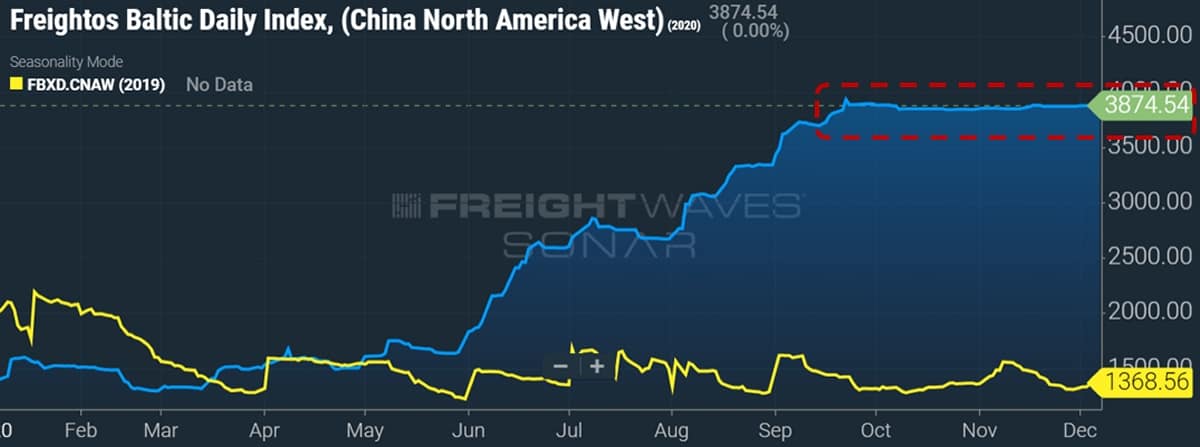Historically strong Asia-U.S. container demand has fluctuated since mid-September. The numbers change from week to week and month to month. It’s not as if trans-Pacific demand hit a peak 10 weeks ago and froze in place.
The strange thing is that spot index rates did exactly that.
Rates differ slightly based upon which source you look at, whether it’s the Shanghai Containerized Freight Index (SCFI), Freightos or Drewry’s. But the pattern is the same.
As of Monday, the Freightos Baltic Daily Index assessed the Asia-West Coast (SONAR: FBXD.CNAW) spot rate at $3,875 per forty-foot-equivalent unit (FEU). It has been within a few bucks of that number since the second half of September.

“It is worth highlighting that this is the first time we have ever seen a flat development,” said Patrik Berglund, CEO and co-founder of freight-rate intelligence company Xeneta, during a company presentation on Tuesday.
“If you look at the charts historically, this has never happened before. It raises some serious questions. The European shippers’ council and the U.S. authorities are keeping their eyes on this, evaluating whether these really are pure, open, competitive market conditions.”
The China meeting
The most common theory on the trans-Pacific’s mysteriously static spot rates is: The Chinese did it.
Chinese officials called a meeting with ocean liners on Sept. 11. During a client call in early October, Jefferies analyst Andrew Lee recounted, “What we heard from the [people in the] meeting themselves was that it wasn’t [regulators saying], ‘You’ve got to cut the rates.’ It was, ‘Carriers are making a lot of money on the trans-Pacific at the moment. Let’s not push it much higher.’”

Whether it is a coincidence or not, index rates halted their ascent within two weeks of the meeting. They haven’t really moved since.
According to Berglund, “The reaction from the Chinese authorities was that these rates were too high and if they broke through $4,000 [per FEU], governments would consider intervening. What’s interesting is that collectively the shipping lines have sort of put a cap on it. They’ve concluded that this is a very healthy market for them and instead of waking up more attention to the industry and creating more fuss, they’ve collectively frozen at that level.”
Future government intervention possible?
Asked by FreightWaves why he thought Asia-West Coast rates are so stable, Freightos Chief Marketing Officer Eytan Buchman pointed to the threat of future government action. “Data across ocean container lanes is a fairly strong indicator of the impact of the potential government intervention,” he said.
“Forty-foot container rates on China-West Coast doubled between early June and mid-September, while China-Europe rates climbed by a tamer 30%.
“Between mid-September’s potential intervention from the Chinese government and the FMC [U.S. Federal Maritime Commission] and today, rates on China-West Coast inched up a measly 3%, while China-Europe rates increased by a full 67%.
“This rate spillover — likely triggered by both congestion and a race for empty containers — is perhaps the best data point behind the looming potential for intervention,” said Buchman. “The underlying conditions — congestion and [lack of] empty containers — have only gotten more aggravated, as rate increases on spillover lanes continue to indicate.”
According to Berglund, “The China-West Coast uptick started in May. The China-South America East Coast uptick started in August and has been even more aggressive. We’ve never seen anything like this [China-South America] rate increase historically. The China-North Europe uptick has come in November and December.
“So, when people ask why authorities in other corridors haven’t stepped in, there’s a lag and I wouldn’t be surprised if there were more scrutiny from governments [in the future on these other trade lanes].”
Is trans-Pacific rate cap for real?
Asia-West Coast volumes have increased during the period when spot index rates have stayed the same. If so, shippers are benefiting from carriers artificially capping their rates, according to the theory that carriers are responding to a perceived regulatory threat.
But what if the spot rate plateau is actually an illusion and the cost to shippers has increased as per the law of supply and demand?
“The rate you see on the Shanghai index is the price you pay for standard, nonpremium services,” said Flexport Global Head of Ocean Freight Nerijus Poskus in an interview with FreightWaves. “But you don’t move a lot of freight these days at that price. You actually have to pay a significant premium on top of that price.
“Some carriers are charging an additional $1,500 or even $2,000 [per FEU] just to guarantee the equipment. What’s the value of having a price of $3,800 or $4,000 if it doesn’t give you space [on a ship] or equipment?”
According to Poskus, “When you see $3,800, that’s not moving freight today on the trans-Pacific eastbound [to Los Angeles/Long Beach]. The people who think that and who think prices have been stable aren’t paying the bills.
“In fact, $3,800 or $4,000 was moving freight in early September. But today, in many cases you have to pay $5,000 or $6,000 [per FEU] just to get space on vessels. Otherwise you have to wait three or four weeks.”
The equipment shortage factor
Yet another theory is that there’s nothing particularly insidious about the apparent trans-Pacific rate plateau.
SeaIntelligence Consulting CEO Lars Jensen told FreightWaves that rate behavior makes sense from the perspective of the global container-equipment shortage.
“Asia-West Coast did indeed reach a plateau [in terms of the nonpremium rate] but that then triggered other trades to start rising sharply. Seen in the context of the equipment, this makes sense.
“If you have one empty container left in Shanghai and you have three people wanting to book to either Los Angeles, Rotterdam or Sydney, who would you give it to? Ideally, you would choose the one the pays the most. Or rather, the one with the highest unit profit.
“When [China-]West Coast rates went through the roof, this placed other shippers on other trades at a disadvantage. They would then become more likely to pay much higher rates to gain access to equipment.
“From a carrier perspective, it would be illogical to keep raising rates on just a single trade lane if the primary shortage was no longer the vessels but the [container] equipment,” maintained Jensen.
Putting high spot rates in context
Finally, record-high spots rates need to be put in perspective vis-a-vis longer-term contract rates.
“We should not forget that this [spot market] is a small portion of the entire trade,” said Xeneta co-founder Thomas Sørbø during his company’s presentation. “Underneath these spot rates, the majority of the business is moved against long-term rates that are at a completely different level.
“There would be a lot more noise [from aggrieved shippers and regulators] if the big shippers with bigger parts of their cargo were at these [spot] levels. For a lot of businesses that would not be sustainable. So, it is going to be extremely interesting to see how this develops in 2021.
For example, said Sørbø, “If we were to think about a scenario where the market for long-term contracts for the big-volume shippers going from Europe to Asia were at the same levels we see in the spot market today, the noise would be a lot louder.” Click for more FreightWaves/American Shipper articles by Greg Miller
MORE ON CONTAINERS: Trans-Pacific boom likely to last into March or longer: see story here. COVID lockdown sequel threatens shipping demand: see story here. Containers are the ‘new gold’ amid ‘black swan’ box squeeze: see story here.







